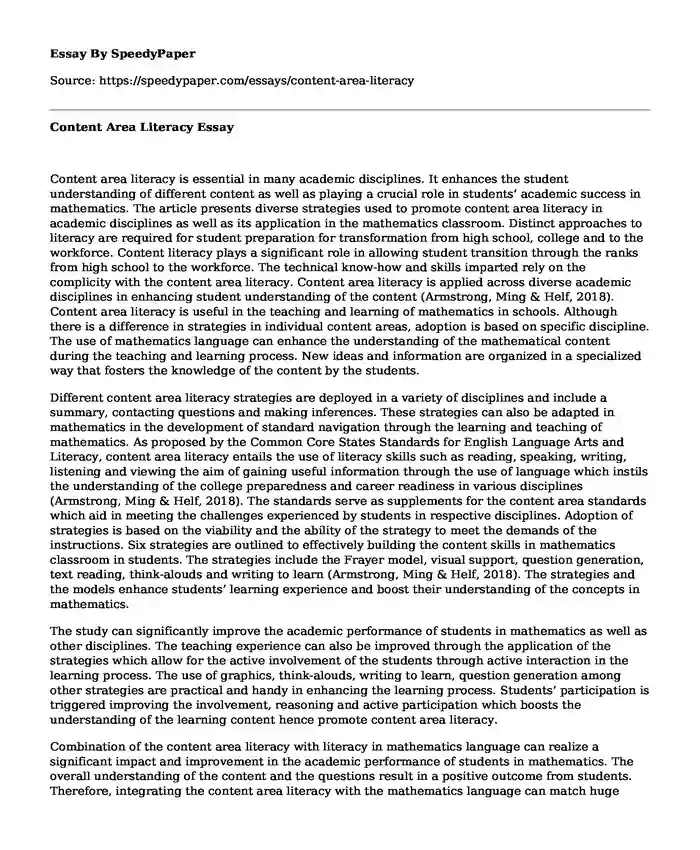
| Type of paper: | Article review |
| Categories: | Psychology Business Law Medicine |
| Pages: | 3 |
| Wordcount: | 657 words |
Content area literacy is essential in many academic disciplines. It enhances the student understanding of different content as well as playing a crucial role in students' academic success in mathematics. The article presents diverse strategies used to promote content area literacy in academic disciplines as well as its application in the mathematics classroom. Distinct approaches to literacy are required for student preparation for transformation from high school, college and to the workforce. Content literacy plays a significant role in allowing student transition through the ranks from high school to the workforce. The technical know-how and skills imparted rely on the complicity with the content area literacy. Content area literacy is applied across diverse academic disciplines in enhancing student understanding of the content (Armstrong, Ming & Helf, 2018). Content area literacy is useful in the teaching and learning of mathematics in schools. Although there is a difference in strategies in individual content areas, adoption is based on specific discipline. The use of mathematics language can enhance the understanding of the mathematical content during the teaching and learning process. New ideas and information are organized in a specialized way that fosters the knowledge of the content by the students.
Different content area literacy strategies are deployed in a variety of disciplines and include a summary, contacting questions and making inferences. These strategies can also be adapted in mathematics in the development of standard navigation through the learning and teaching of mathematics. As proposed by the Common Core States Standards for English Language Arts and Literacy, content area literacy entails the use of literacy skills such as reading, speaking, writing, listening and viewing the aim of gaining useful information through the use of language which instils the understanding of the college preparedness and career readiness in various disciplines (Armstrong, Ming & Helf, 2018). The standards serve as supplements for the content area standards which aid in meeting the challenges experienced by students in respective disciplines. Adoption of strategies is based on the viability and the ability of the strategy to meet the demands of the instructions. Six strategies are outlined to effectively building the content skills in mathematics classroom in students. The strategies include the Frayer model, visual support, question generation, text reading, think-alouds and writing to learn (Armstrong, Ming & Helf, 2018). The strategies and the models enhance students' learning experience and boost their understanding of the concepts in mathematics.
The study can significantly improve the academic performance of students in mathematics as well as other disciplines. The teaching experience can also be improved through the application of the strategies which allow for the active involvement of the students through active interaction in the learning process. The use of graphics, think-alouds, writing to learn, question generation among other strategies are practical and handy in enhancing the learning process. Students' participation is triggered improving the involvement, reasoning and active participation which boosts the understanding of the learning content hence promote content area literacy.
Combination of the content area literacy with literacy in mathematics language can realize a significant impact and improvement in the academic performance of students in mathematics. The overall understanding of the content and the questions result in a positive outcome from students. Therefore, integrating the content area literacy with the mathematics language can match huge steps in realizing the best students' outcome in mathematics performance.
The article highlights some of the critical considerations in enhancing the understanding of mathematics through the embracing content area literacy. The strategies outlined gives the students and the teachers an easy time in comprehending different content not only in mathematics but also in other disciplines. Application of specific strategies is based on the best approach that realizes the best outcome from the students. The presentation structure of the article is clear and easy for understanding across different classroom settings.
References
Armstrong, A., Ming, K., & Helf, S. (2018). Content area literacy in the mathematics classroom. The Clearing House: A Journal of Educational Strategies, Issues and Ideas, 91(2), 85-95.
Cite this page
Content Area Literacy. (2022, Dec 15). Retrieved from https://speedypaper.com/essays/content-area-literacy
Request Removal
If you are the original author of this essay and no longer wish to have it published on the SpeedyPaper website, please click below to request its removal:
- Labelling Theory - Free Essay in Social Psychology
- Development of Animal Research - Essay Example
- Free Paper with a Report on BMW's Contemporary Business Strategy
- Subject: Advisory Memo on Polio in Nigeria
- Physical, Psychological and Sexual Abuse - Free Essay Sample
- Essay Sample on Slavery, Dueling, and Identity
- Paper Example. Addressing the Needs of the Patients and Their Families
Popular categories




